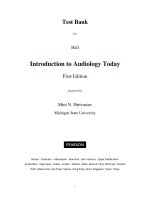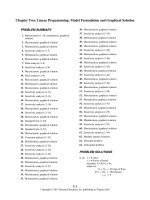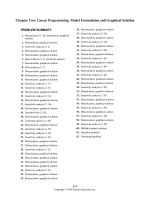Introduction to interdisciplinary studies 1st edition by repko szostak buchberger test bank
Bạn đang xem bản rút gọn của tài liệu. Xem và tải ngay bản đầy đủ của tài liệu tại đây (238.51 KB, 6 trang )
Introduction to Interdisciplinary Studies 1st edition by Allen F. Repko,
Rick Szostak, Michele Phillips Buchberger Test Bank
Link full download test bank: />
Chapter 2: Interdisciplinary Studies Defined
The questions for this chapter are divided into categories that correspond to the levels of
learning in Bloom’s taxonomy as modified by Anderson et al. (2000) as follows:
Level 1: Remembering or recalling factual information (such as definitions of key terms)
Level 2: Understanding key concepts and theories (that are foundational to the field such
as perspective taking)
Level 3: Applying concepts to specific situations that are hypothetical or real world Level
4: Analyzing (a text or case or hypothetical situation to identify its parts and explain its
meaning)
Level 5: Evaluating (a text or case or hypothetical situation to see if it meets certain
criteria).
Organizing questions in this way allows you to determine the degree of difficulty of the
quiz or exam.
The types of questions include multiple choice and short response. The wording of each
question and the correct response to it corresponds closely to the wording in the text.
Each question is accompanied by a page reference for two purposes: to enable you to
easily reference the source of the question, and to enable students to do likewise when
reviewing the exam. Experience has shown that this approach greatly reduces student
complaints about the fairness of a question and the validity of the correct response.
CHAPTER 2
Level 1: Remembering or recalling factual information
B
1. The noun and term describing the “intellectual essence” of the field of
interdisciplinary studies is (p. 24)
a. Interdiscipline.
b. Interdisciplinarity.
c. Cross disciplinarity.
C
2. Scholarly contributions to the clear understanding of a complex problem,
object, or text are called (p. 24)
a. Defining elements.
b. Theories.
c. Insights.
SAGE Publications, Inc. © 2014
1
Repko, Introduction to Interdisciplinary Studies 1e
Instructor Resource
A
3. Careful analysis of a text that begins with attending to individual words,
sentence structure, and the order in which sentences and ideas unfold is
called (p. 26)
a. Close reading.
b. Systems thinking.
c. Superficial reading.
B
4. Your “cognitive” or “intellectual” ability to think, perceive, analyze,
create, and solve problems is called (p. 27)
a. Potential.
b. Capacity.
c. Creativity.
B
5. A cognitive process by which individuals or groups draw on disciplinary
perspectives and integrate their insights and modes of thinking to
advance their understanding of a complex problem with the goal of
applying it to a real-world problem is the definition of (p. 28)
a. Multidisciplinary studies.
b. Interdisciplinary studies.
c. Transdisciplinary studies.
C
6. A branch of learning or body of knowledge such as physics, psychology,
or history is called (p. 30)
a. A university.
b. A department.
c. A discipline.
A
7. The system of knowledge specialties which is little more than a century
old is called (p. 30)
a. Disciplinarity.
b. Interdisciplinarity.
c. The university.
C
8. The “divide and conquer” strategy which reduces complex things to
simpler things is called (p. 31)
a. Multidisciplinarity.
b. Interdisciplinarity.
c. Disciplinary reductionism.
A
9. The placing side by side of insights from two or more disciplines without
attempting to integrate their insights is called (p. 31)
a. Multidisciplinarity.
b. Transdisciplinarity.
c. Disciplinarity.
SAGE Publications, Inc. © 2014
2
Repko, Introduction to Interdisciplinary Studies 1e
Instructor Resource
C
10. A figure of speech in which a word or phrase, a story, or a picture is
likened to the idea that you are trying to communicate is called (p. 32)
a. A phrase.
b. Critical analysis.
c. A metaphor.
B
11. The cooperation of academics, stakeholders, and practitioners to solve
complex problems of common interest with the goal of resolving them
by designing and implementing public policy is called (p. 36)
a. Multidisciplinarity.
b. Transdisciplinarity.
c. Interdisciplinarity.
C
12. The form of interdisciplinarity that questions disciplinary assumptions
and ideological underpinnings and, in some cases, aims to replace the
existing structure of knowledge and the system of education based upon
it is called (p. 37)
a. Transdisciplinarity.
b. Instrumental interdisciplinarity.
c. Critical interdisciplinarity.
13. Of the 10 cognitive capacities developed by interdisciplinarity, identify
five: (p. 27)
1. ________________________________________________________________
2. ________________________________________________________________
3. ________________________________________________________________
4. ________________________________________________________________
5. ________________________________________________________________
Level 2: Understanding key concepts and theories
A
1.
a.
b.
c.
The purpose of interdisciplinary studies is to (p. 27)
Develop your capacity to integrate and apply knowledge
Replace the disciplines.
Focus less on the university and more on the real world.
A
2.
a.
b.
c.
The product of interdisciplinary studies refers to (p. 28)
A more comprehensive understanding of the problem.
A critical analysis of the problem.
The process used to approach the problem.
SAGE Publications, Inc. © 2014
3
Repko, Introduction to Interdisciplinary Studies 1e
Instructor Resource
B
3. The underlying premise of interdisciplinary studies is that (pp. 28-29)
a. The disciplines are an obstacle to the progress of knowledge.
b. The disciplines are themselves the necessary foundation of the
interdisciplinary enterprise.
c. The disciplines should be replaced by multidisciplinary,
interdisciplinary, and transdisciplinary approaches.
A
4. In the “Fable of the Elephant House,” this approach is evident in the
conversation between the psychologist and sociologist about the possible
number of elephants that might inhabit the house: Psychologists study
individuals whereas sociologists study groups: (p. 31)
a. Disciplinary reductionism.
b. Disciplinary competition.
c. Transdisciplinary policy concerns.
C
5.
a.
b.
c.
A
6. When a problem is simple or multifaceted but not complex, this approach
should suffice: (p. 35)
a. Multidisciplinary.
b. Interdisciplinary.
c. Transdisciplinary.
C
7. The form of interdisciplinarity that adopts an attitude of suspicion and
calls into question not only research data, but also the researcher, the
research design, and the interpretation of findings is called (p. 37)
a. Instrumental interdisciplinarity.
b. Metaphorical interdisciplinarity.
c. Critical interdisciplinarity.
A
8. This form of interdisciplinarity embraces the full diversity of authors and
perspectives, rather than rejecting their legitimacy, and seeks to create
commonalities between conflicting disciplinary insights, integrate these,
and construct more comprehensive understandings: (p. 38)
a. Instrumental interdisciplinarity.
b. Critical interdisciplinarity.
c. Analytical interdisciplinarity.
The bowl of fruit metaphor illustrates (p. 33)
Interdisciplinary integration.
Disciplinary reductionism.
Multidisciplinary juxtaposition.
SAGE Publications, Inc. © 2014
4
Repko, Introduction to Interdisciplinary Studies 1e
Instructor Resource
B
9. Strengths of this metaphor are its depicting interdisciplinary studies is
something that takes place between two (or more) disciplines and that it
has an applied orientation. (pp. 44-45)
a. Bilingualism
b. Bridge building
c. Boundary crossing.
B
10. A weakness of this metaphor is that it conveys the incorrect notion
that disciplines are static rather than dynamic entities (pp. 45-46):
a. Bridge building
b. Boundary crossing.
c. Bilingualism.
Level 3: Applying concepts to specific situations that are hypothetical or real world
C
1. It is useful to explain why definitions of key concepts such as
interdisciplinarity matters because (p. 23)
a. The definition of interdisciplinarity is so similar to that
of multidisciplinarity studies.
b. It is important that you develop your own definition of key concepts.
c. How you define a word is critical to any effort you make to understand it.
A
2. The “Fable of the Elephant House” illustrates a multidisciplinary
approach to solving a complex problem because (p. 32)
a. The disciplinary experts completed the house for only 15% above the
original estimate.
b. The disciplinary experts spoke with separate voices and their perspectives on
the problem were presented in serial fashion.
c. The disciplinary experts formed a committee which was led by an one of
their members.
Level 4: Analyzing (a text or case or hypothetical situation to identify its parts and
explain its meaning)
A
1. One of the primary objectives of Chapter 2 is to
a. Define interdisciplinary studies.
b. Present arguments supportive of critical interdisciplinarity.
c. Identify limitations of three commonly used metaphors.
A
2. The point of the example of the Fair Tax Rally is to (pp. 23-24)
a. Illustrate how a term such as “fair” can have different meanings when used by
different groups.
b. Argue that the rich need to pay more taxes.
c. Illustrate the point that some people prefer a vague rather than a precise
definition of a key term.
SAGE Publications, Inc. © 2014
5
Repko, Introduction to Interdisciplinary Studies 1e
Instructor Resource
Level 5: Evaluating (a text or case or hypothetical situation to see if it meets certain
criteria)
C
1. The position of this book on instrumental and critical interdisciplinarity
is that (p. 38)
a. The two conceptions are diametrically opposed and unbridgeable.
b. The critical conception is to be preferred over the instrumental conception.
c. Both conceptions share this commonality: They question the disciplines.
SAGE Publications, Inc. © 2014
6









